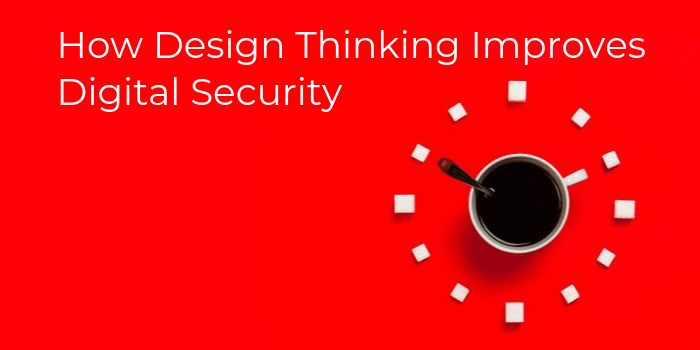Big data is a big deal for all businesses. As they use it more and more for the sake of improving their products and services, they encounter a major challenge: securing it.
You’ve been thinking about ways to improve data privacy and digital security, but have you ever considered including design thinking in the process?
Let’s tackle these issues one by one, and then we’ll make a connection between them.

What Is Design Thinking?
As a concept, design thinking is borrowed from the working process of a designer. Samsung, Google, Apple, and other leading tech companies have adopted this approach.
Through this process, the designer tries to understand the user of the end product. They redefine problems and challenge assumptions, so they can provide solutions before the problem even appears. Design thinking develops through five stages:
- Empathy
- Definition
- Idea generation
- Prototype creation
- Testing
After the test, the designer identifies problems and the stage where they appeared. As needed, they will go back to any of the previous stages to solve the issues. They will learn something new about the users, redefine the problem, test new ideas, or change the prototype.

What Is Digital Security?
When people use an app, they want to know what data it collects from their devices. They want to know how the app developer uses that data. When they access a website, they wanna know what the cookies do. All policies should be transparent.
Here’s an example: when a student gets online assignment help, they want to make sure their privacy is protected. If the company sells user details to third parties, the student risks getting exposed. The last thing they want to face is a data leak that lets a professor find out they bought papers online. So these services have to protect digital information, just like any other business has to keep the data of its users safe.
What Does Design Thinking Have to Do with Digital Security?

Design thinking and digital security look like entirely different concepts. But if we implement the design thinking process into the development of digital security standards, we’ll be surprised with the results.
The point of design thinking is to develop solutions that go to the user’s advantage. The consumer-centric perspective lets us understand the worries of the customers. When we target those worries, we can develop improved security standards that bring peace of mind.
This is how businesses can benefit from the design thinking process through its stages:
#1 Understand the Needs of Your Users and Set Them as Challenges to Solve
Empathy is the first stage. You need to observe the current data protection strategy from a user’s point of view.
- Are the policies transparent enough?
- How do your users feel about them?
- What can you do to make the users feel more confident about sharing data with your business?
- Is there a digital security model that they consider perfect?
Feel free to use surveys during this stage. Instead of assuming what your target audience thinks, you might as well ask.
#2 Define the Problems
Create a list of all issues your users have with your current digital security standards. Find out what the weaknesses are. Figure out where you want to get from this point until the end of this project.
You can use this as a starting point to identify potential areas of improvement and define goals for your project:
- Inadequate Authentication: Weak or easily guessable passwords, lack of multi-factor authentication, or insufficient user verification methods.
- Vulnerable Network Infrastructure: Unsecured or poorly configured network devices, such as routers or firewalls, which can be exploited by attackers.
- Lack of Encryption: Failure to encrypt sensitive data during transmission and storage, increasing the risk of unauthorized access.
- Insufficient Patch Management: Failure to apply security patches and updates in a timely manner, leaving systems exposed to known vulnerabilities.
- Weak Endpoint Security: Inadequate protection for devices (e.g., computers, smartphones, IoT devices) connected to the network, making them susceptible to malware and unauthorized access.
- Ineffective Access Controls: Improper access rights and permissions, unauthorized privilege escalation, or lack of segregation of duties.
- Social Engineering Attacks: Lack of user awareness and education regarding phishing, social engineering, and other forms of manipulation used by attackers to gain unauthorized access.
- Insecure Third-Party Integrations: Integration of third-party services or software with weak security measures, which can introduce vulnerabilities into the system.
- Data Breach Response: Insufficient incident response procedures and communication plans to effectively address and mitigate the impact of a data breach.
- Compliance and Regulatory Issues: Failure to meet industry-specific security standards and legal requirements, leading to potential penalties and reputational damage.
To determine the specific weaknesses and issues faced by your organization, it is recommended to conduct a comprehensive security assessment and involve stakeholders from various departments. From there, you can define specific goals and objectives for your project, such as:
- Enhancing user authentication and access controls to strengthen account security.
- Implementing encryption mechanisms to protect sensitive data at rest and in transit.
- Improving network security by strengthening firewall configurations and monitoring network traffic.
- Establishing a robust patch management process to ensure timely updates and fixes.
- Implementing endpoint protection solutions and enforcing security policies on devices.
- Conducting regular security awareness training to educate users about common threats and social engineering attacks.
- Assessing and monitoring the security of third-party integrations and suppliers.
- Developing an incident response plan and conducting regular drills to effectively handle data breaches.
- Ensuring compliance with relevant security standards and regulations applicable to your industry.
Remember to tailor these goals to your organization's specific needs, resources, and risk appetite. Regular review and adaptation of the security standards and objectives are also crucial to keep up with evolving threats and technology.
#3 Generate Ideas

How will you solve the issues that your customers face regarding digital security? This is the most important stage of the process, where you come up with potential technical solutions. You will need a team of data scientists and programmers to go through this stage. If you don’t have them in your team, here’s where you’ll find them:
- Upwork – It’s a freelancing platform where you can work with professionals from all around the world.
- PeoplePerHour – Another freelancing platform, but it’s less crowded than Upwork so it’s easier to hire the right person for your project.
- BestEssayServicesReview – Read reviews on specialized writing services, which offer help with programming and data science projects.
When you build your team, you’ll work together to find ideas that work.
#4 Create a Prototype
Through the design thinking process, the team works block by block on the issues. They develop small prototypes and build on them. When you start with the customer’s benefit as a foundation, the prototype will work for them.
What Do You Advocate?
Creating a prototype involves building a simplified version of a product or solution to test and validate its functionality, usability, and effectiveness. Here's a step-by-step guide on how to create a prototype:
- Define the Scope: Based on the selected idea, clearly define the scope and purpose of the prototype. Determine what specific aspects or features you want to focus on and what you aim to achieve through the prototype.
- Determine the Level of Fidelity: Decide on the level of fidelity or the degree of detail and functionality your prototype should have. Prototypes can range from low-fidelity (simple and basic) to high-fidelity (more polished and closer to the final product). The fidelity level depends on the purpose of the prototype and the stage of the design process.
- Choose the Prototype Format: Select the appropriate format for your prototype based on the complexity and nature of your solution. Prototypes can take various forms, such as paper sketches, wireframes, interactive mockups, physical models, or even functional prototypes with limited features.
- Build the Prototype: Start building the prototype block by block, focusing on one key feature or aspect at a time. Begin with the most critical functionality that directly addresses the user's benefit. Use the chosen format and relevant tools or software to create the prototype. For low-fidelity prototypes, you can use paper, sticky notes, or simple design tools. For higher fidelity prototypes, consider using software applications, prototyping tools, or even coding if necessary.
- Test and Gather Feedback: Once you have a working version of your prototype, test it with real users or stakeholders. Observe their interactions, gather feedback, and ask for their thoughts and suggestions. Pay attention to their experience, pain points, and how well the prototype addresses their needs. This feedback will help you iterate and improve the prototype in subsequent versions.
- Iterate and Refine: Based on the feedback received, analyze the findings, identify areas for improvement, and refine the prototype. Incorporate the suggested changes, add additional features or details, and iterate on the prototype. Repeat the testing and feedback process to ensure continuous improvement.
- Repeat the Process: Repeat the prototype-building process, focusing on different aspects or features, until you have a well-rounded and validated solution. Each iteration should bring you closer to the final product or solution that meets the user's needs and provides the intended benefits.
Remember that prototyping is an iterative process, and it's essential to involve users and stakeholders throughout the design and development journey. By building prototypes block by block and incorporating user feedback, you can create a solution that truly works for the customers and addresses their needs effectively.
#5 Test It
This is the point where you test the new terms of service and security standards. Some vulnerabilities might still appear. In that case, the team will go back to one of the previous stages to rework the issues.
Do you see the connection? If you’re trying to develop better digital security standards that make your business trustworthy, the design thinking process will help you succeed.

Justin Osborne loves to share his thoughts and opinions about education, writing and blogging with other people on different blogs and forums. Currently, he is working as a content marketer.
Author // Justin Osborne

Thank you for your invaluable article. There is so much to learn from your article as well as your website.
In some parts, I really don’t know what you are talking about but designing like this takes years of practicing so I’m looking for a coach to take me through.
Thank you for such an insightful information.
I really appreciate it.
Also happy birthday to you.
Thanks for sharing this. It is really useful.